Gun Tests Magazine has been testing ammunition for 25 years, with a broader reach of considerations to look at and more samples tested head to head, out of the same guns and by the same shooters at the same time. In particular, our testers said too much ammunition testing focused on terminal performance — that is, what bullets did after they hit the target and not much at all about how the bullet got to the target. This listing contains results for 9mm Luger and 9mm Luger +P.
Certainly, terminal performance is important, but getting the bullet on target is much more important, in our view, so much of our focus is on performance before the bullet hits the target. Because we realize that results from our test gun can’t be extrapolated to every possible gun readers might own, we wanted to test ammunition in a fashion most consumers would be able to duplicate, and in fact, should conduct on their own. But our framework can potentially save you money and time by narrowing the list of candidates you might try in your own gun, and you can also follow our system to see if a given round performs for you like it did for us.
We set stringent standards for reliability, consistent velocity, accuracy, and controllable recoil level — four crucial aspects of performance that allow you to put rounds on a target, paper or otherwise. In more detail, here’s how we test ammunition.
Test 1: Reliability
Reliability is the non-negotiable baseline for a self-defense gun. Before anything else is considered, the gun must go bang every time you pull the trigger. We settle for nothing less than 100 percent reliability. We also caution you that any round we recommend must be tested in your own gun. We can get you started, but your guns have to like your rounds. If you’ve had reliability issues with certain rounds in your firearms, we’d love to hear about it in the comments below.
Test 2: Velocities and Standard Deviation Reporting
The ammunition must generate consistent velocities. Wild shot-to-shot velocity variances are not desirable in defensive ammunition. In addition to affecting bullet performance (accuracy, penetration, expansion), velocity swings make it much harder to fire the gun fast and well. We report both average velocities for at least 10 rounds and the resulting standard deviation from those velocities. Standard deviation tells you how close you can expect the velocity of any shot you fire to be to the average velocity. A small standard deviation is always a sign of ammunition that’s been assembled with skill and attention to detail.
Test 3: Accuracy
We expect variations between how our gun performs and how yours shoot with the same ammo brand. Accuracy results do vary from gun to gun and shooter to shooter. However, egregious accuracy in a quality gun is never a sign of good ammunition. For testing in your own gun, we recommend starting with our winners and seeing how they shoot in your guns. If they shoot well, then you can keep them as your personal defense loads.
Test 4: Recoil Level
Ammunition for self-defense must not generate such heavy recoil that it’s difficult to control for the typical, reasonably well-practiced shooter. The method we use for assessing shooter reaction to recoil is to calculate IPSC Power Factor (pf). To arrive at a round’s IPSC Power Factor, take the bullet weight in grains, multiply it by the velocity in feet per second, then divide by 1000. The resulting number is the power factor.
Example: A typical 9mm defense load is a 115-grain jacketed hollow point moving at 1150 fps. 115 x 1150 = 132,250/1000 = 132.25 Power Factor.
In our subjective experience in evaluating firearms with hundreds of shooters over the years, we’ve learned that most shooters do best with a recoil level not exceeding 150 PF. Ideally, the 125- to 150-PF range seems to give a good balance of power with controllability.
Test 5: Penetration, Expansion, and Weight Retention
Any rounds meeting all criteria for reliability, consistent velocity, accuracy, and controllable recoil, are then fired into water. Water generates the same results, vis-a-vis penetration and expansion, as 10-percent ordnance gelatin. It just slightly overstates expansion and penetration. Take the expansion and penetration results in water, delete 10 percent, and you know what a bullet would do in gelatin. For example, a bullet that travels 15 inches in water would penetrate 13.5 inches in ordnance gelatin (15 inches water – 1.5 inches (10%) = 13.5 inches).
Recovered bullets are then measured for expansion with dial calipers and on an electronic scale for weight retention (that is, how much of the bullet is left after penetration and expansion).
When all is said and done, we recommend ammunition in this listicle that is put together with care and craftsmanship; that is functionally reliable in our test guns; that generate consistent velocities; and that is accurate and controllable as well. Penetration, expansion, and weight retention data on such loads is provided for your information in the original articles.
Happily, we’ve encountered very few bad products, but we did find a few favorites that were listed as Best Buys or Our Picks, the latter category not being constrained by price at the time of the test. However, because of the variability of ammunition prices, we’ve redacted the prices for this list. As always, you can read the full review about a particular round in the monthly issues cited in each listing. We’ve verified that the ammunition in the Top 10 list is still available under the cited model numbers listed. — Todd Woodard
10 Fiocchi 115-grain Hyperformance Defense Hornady XTP JHP 9XTP25 9mm Luger (October 2013)
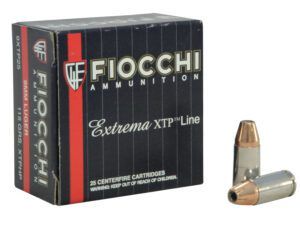
This loading is the slowest of the 115- to 124-grain bullets, making it easily the most controllable load tested. Accuracy was best of the test, and considering the size of the pistol and the short sight radius, the light recoil has much to do with the practical accuracy. Expansion was modest, but penetration ideal at 12 inches. Looking at the whole picture – good control, accuracy, enough penetration, and a great price – puts this load at the top.
Gun Tests Grade: A (Best Buy)
9 Norma MHP 108-Grain Monolithic Hollow Point 9mm Luger 299740020 (May 2023)
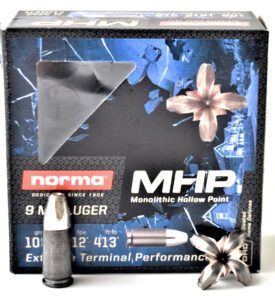
Monolithic simply means the projectile is manufactured from a single piece of copper. This was the lightest projectile tested at 108 grains. The company claims more than 1300 fps velocity. Actual recorded velocity was 1198 fps average. The Norma load was accurate enough, but it was not the most accurate load in the test. Felt recoil was subjectively lightest of the test. Penetration was adequate at 16 inches. Expansion was the greatest at 0.95 inch. We were impressed by the Norma 108-Grain Monolithic Hollow Point’s performance. It offers a combination of light recoil, acceptable accuracy, and a fast-opening bullet.
Gun Tests Grade: A
8 Barnes TAC-XPD 115-Grain X Bullet 9mm Luger 21551 (May 2023)
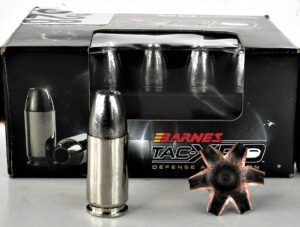
The Barnes all-copper hollow point was once pricey compared to other loads. Now it is in line with what other 20-round boxes cost. The all-copper bullet is long for the bullet weight and cannot be loaded as hot as a conventional cup-and-core bullet because the bullet base extends further into the cartridge case. Just the same, the velocity of 1143 fps makes for easy control. This bullet offers very consistent penetration of 18 inches in water and expands to 0.73 inch.
Gun Tests Grade: A
7 DoubleTap +P 147-Grain JHP 9mm Luger (November 2018)
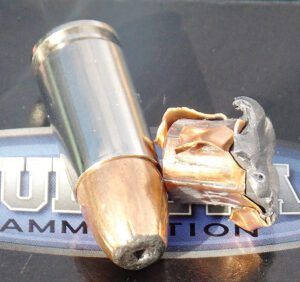
This is the fastest load tested in this issue at 1121 fps. That is 38 Super category. Yet, there were no adverse pressure signs in the spent cases. The 147-grain JHP penetrated 22 inches of water and expanded to 0.55 inch. We did not recognize the bullet used, but it appears to be a design intended to limit early penetration. We do not think it is a bonded design, although the jacket and bullet stayed together. This load certainly caused a ruckus in the water jugs. We think that a combination of careful powder selection and long-loading the bullet allowed the company to achieve this velocity. This load is worth considering, but it should be fired in a service pistol such as the Glock 19X, not a compact handgun, to maximize its effects.
Gun Tests Grade: A
6 Speer Gold Dot 124-grain +P Short Barrel JHP 23611 9mm Luger (October 2013)
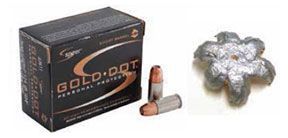
The current ammunition shortage almost prevented this load from appearing in these pages. Most of the others were on hand. The Speer load was difficult to obtain, but then everything is at present. The Gold Dot design is tweaked for extra performance in the short-barrel gun. The +P rating increases velocity over the standard Gold Dot, and the bullet features a softer core. Expansion and penetration were excellent. This is a solid choice for all-around use. This load is specifically intended for short-barrel use, and as a result of careful development and quality manufacture, it was the overall pick of our raters.
Gun Tests Grade: A+
5 Winchester USA Ready Defense 124-Grain Hex-Vent JHP 9mm Luger +P RED9HP (20) (May 2023)
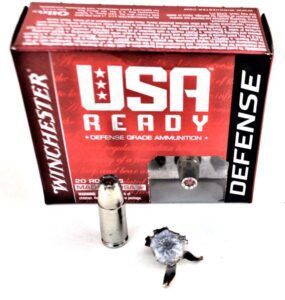
This new loading uses something called Hex-Vent technology. A polymer ball in the nose instigates expansion. This load breaks 1207 fps, making it the most energetic 124-grain load tested. The bullet stayed together and expanded well as it penetrated 16 inches of water. We measured the lead mushroom at a healthy, plump 0.76 inch of expansion. Had we included in the expansion measurement the single piece of jacket that was attached to the center, the reading would have been well over an inch. One of the bullets of three tested in water slipped its jacket, a mark of a high-velocity bullets. This is outstanding performance by any standard.
Gun Tests Grade: A+
4 Buffalo Bore Standard Pressure 147-grain JHP 24I 9mm Luger (November 2018)
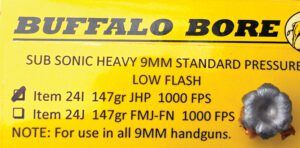
This is a standard-pressure-rated load with plenty of momentum. Velocity is 998 fps. Accuracy is good. For some reason control was no more difficult than the slower loads, perhaps because of fast-burning powder, but most likely the 9mm’s general pleasant firing characteristics. While the Fiocchi and Winchester loads had less recoil, we did not find the Buffalo Bore load daunting at all. The question is, do you believe in one hard hit or two or three softer hits and use a +P load? Only the shooter may answer that question, and it depends upon personal ability. The Buffalo Bore load is controllable by those who practice, and it offers good penetration and expansion without +P pressure. Penetration was 21 inches of water. The jacket comprised part of the expanded diameter at an impressive 0.75 inch.
Gun Tests Grade: A
3 Remington Golden Saber Bonded 147-Grain Jacketed Hollow Point 9mm Luger 29343 (May 2023)
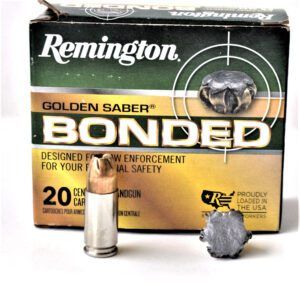
This bullet doesn’t quite look like the Golden Saber bullets tested in the past. These bullets used more of the bullet jacket as a wounding mechanism. The bane of 147-grain loads has been low velocity and expansion. The Remington bonded load breaks a solid 1012 fps, marginally faster than the 147-grain Winchester load. Penetration was 20 inches, and expansion was an average of 0.58 inch. If you need deeper penetration and prefer a 147-grain bullet, Remington has provided an answer.
Gun Tests Grade: A
2 Federal Premium Law Enforcement 124-Grain HST Jacketed Hollow Point 9mm Luger P9HST1 (May 2023)
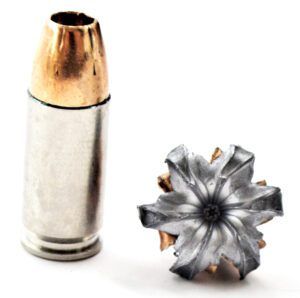
The HST bullet is a modern development that offers a choice over the Hydra-Shok. There is no center post in the HST, and its expansion is different. Velocity was 1153 fps. Penetration was 17 inches in water and expansion 0.65 inches. Recovered weight was 124 grains. The HST offers slightly better performance than the Hydra-Shok. We would take either.
Gun Tests Grade: A
1 Hornady Critical Duty FlexLock +P 135-Grain 90226 9mm Luger (November 2018)
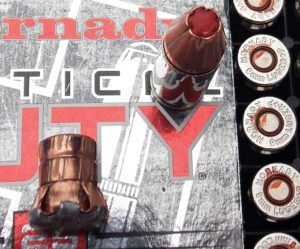
This load offers excellent barrier penetration, according to Hornady and agency testing. Our water test showed a bullet that drove to 24 inches in water testing and expanded consistently to 0.48 inch. (Bullet #2 made a dent in the fifth jug; #3 was stuck in the #4 jug’s outer jacket.) Every bullet looked exactly the same, with the most consistent expansion of the test. The Hornady bullet offered excellent accuracy as well, tying the Fiocchi loading for most accurate and only in second place for accuracy by splitting hairs. The Hornady bullet has plenty of penetration, and we feel that this load is a serious contender for law-enforcement use. If traveling in country inhabited by big cats and feral dogs, this is a good choice. The needs of law enforcement and the needs of home-defense shooters may be different, but this is an outstanding loading for either group.
Gun Tests Grade: A
OTHER TESTED LOADS
Winchester Silvertip 147-Grain Jacketed Hollow Point 9mm Luger W9MMST2 (20) (May 2023)
Winchester’s 115-grain Silvertip has been a staple for personal defense for decades. The 147-grain version is intended to offer more penetration and offer an alternative to bonded-core police-type loads. Velocity was 980 fps, penetration 18 inches, and expansion 0.61 inches. For a heavyweight bullet, we feel the Silvertip offers good performance. Compared to the Golden Saber from Remington, the Silvertip expands slightly more and penetrates slightly less. We would be pleased with either.
Gun Tests Grade: A
Speer Gold Dot 124-Grain JHP 9mm Luger 23618GD (May 2023)
The Gold Dot is designed to offer excellent light cover and barrier penetration. This means a great deal in law enforcement, but not so much in civilian personal defense. The Gold Dot bullet breaks 1124 fps out of the Walther PDP. Penetration in water was 18 inches, and expansion was a solid 0.64 inch. We like the accuracy and reliable expansion of this loading.
Gun Tests Grade: A
Federal Premium Law Enforcement 124-Grain Hydra-Shok Jacketed Hollow Point 9mm Luger P9HS1G1 (May 2023)
In testing, the load clocked 1104 fps. Penetration was 16.5 inches of water. Expansion was 0.59 inch, with weight retention of 122.5 grains. Interestingly, decade-old testing of this round shows 1090 fps average velocity, the same penetration, and 0.55 inch expansion. The modern Hydra-Shok is an improved cartridge and one with a proven track record.
Gun Tests Grade: A
Federal Premium Hydra-Shok Deep 135-Grain PD9HS5H 9mm Luger (November 2018)
This loading isn’t the same as the previous 135-grain Low Recoil Federal cartridge. The bullet design is optimized for penetration, and in our test, we got an average of 22 inches of penetration. The Hydra-Shok bullet features a fold-over crimp on the jacket, which we believe is designed to keep the bullet jacket from opening too soon. Velocity is higher than expected at 1035 fps. Total expansion was the greatest of any load tested at 0.79 inch; however, this was due to a part of the jacket extending from the 0.59-inch mushroom. That shard would still be effective regardless.
Gun Tests Grade: A
Federal Premium HST 147-Grain P9HST2 9mm Luger (November 2018)
The 147-grain bullet features the popular HST design, which is intended as an improvement over the Hydra-Shok. The HST offers an advantage in barrier penetration. We do not test barrier penetration, but expansion in water was very good and so was penetration. This load proved accurate and exhibited a clean powder burn. We felt that the HST provided optimum performance. This is a load that would convince shooters to adopt the 147-grain load over the 124-grain JHP. At 1006 fps with 22 inches of penetration and 0.68-inch recovered diameter, this is a good choice.
Gun Tests Grade: A
Federal Premium HST +P 147-grain P9HST4 9mm Luger (November 2018)
This appears to be the same bullet used in the standard-pressure loading. The HST +P is an answer to those looking for increased velocity and performance in the 147-grain weight. However, the standard-pressure load is faster than almost all standard-pressure 147-grain loads anyway, which usually average 930 to 980 fps, so Federal did something there. On average, the 147-grain HST +P is 24 fps faster than the standard-pressure loading. This may not seem worthwhile, but we did not expect bullet performance to be as different as it was. Two inches less penetration was achieved with a bullet that expands to .70 versus .68. For civilian versus law-enforcement shooters, this performance might be a better choice, but when a non +P load offers good performance, there is little incentive to add pressure. No increase in recoil was noted.
Gun Tests Grade: A
Winchester PDX1 Defender 147-Grain S9MMPDB1 9mm Luger (November 2018)
The Winchester PDX Defender is a bonded-core design like the rest of the loads tested. The Winchester load breaks 940 fps and offers good control. Accuracy is good, and the powder burn is clean. Muzzle flash is limited. In other words, this is a service-grade loading. Penetration is optimal, and the bullet expands to 0.57 inch reliably. The Winchester load is a viable choice with good performance.
Gun Tests Grade: A
Remington HD Ultimate Defense 147-Grain Brass-Jacketed HP 28946 9mm Luger (November 2018)
The Golden Saber used a brass jacket over a lead bullet. The jacket is actually designed to be part of the wound mechanism. It is designed for the rigors of law enforcement, but non-LE shooters can buy it. The Golden Saber expanded to .70 inch, excellent results. Velocity was 940 fps and penetration a deep 24 inches. The Golden Saber is accurate and fired a total of 50 trouble-free rounds.
Gun Tests Grade: A
Buffalo Bore Outdoorsman Hard Cast Lead Flat Nose 147-Grain 24L/20 9mm Luger (November 2018)
This isn’t a jacketed-bullet load, but is rather a hard-cast flat-nose bullet intended for defensive use against larger animals. Many folks use the 9mm for personal defense, and rather than purchase a Magnum revolver for occasional use in the wild, they might find it handy to load the 9mm with high-penetration bullets. FMJ loads typically cut a small wound path, but the Flat Point should create more damage. We found the Buffalo Bore load is a strong choice at a solid 1060 fps average. We cannot tell you the true water penetration because we gave up at 48 inches. We tried to capture the bullet in 42 inches of water, or seven jugs, and it sailed through. Next, we tried eight jugs at 48 inches, the limit of the fixtures we use for holding the water jugs. It sailed through. The exit hole was more ragged than we have seen with FMJ loads. We felt that this is more than adequate penetration. We are not rating this loading compared to the others because it is unique, but it certainly fits in with the deep-penetrating 9mm line of this report. In an urban situation, it’s probably not the right choice because it might strike a person beyond your target. Penetration is at least in 357 Magnum territory.
Gun Tests Grade: A
SIG Sauer Elite V-Crown 147-Grain E9MMA3-20 9mm Luger (November 2018)
The 147-grain V-Crown averaged 962 fps, right in the league with several other loads with practically identical velocity. The V-Crown was also a good performer, with penetration of 20 inches and expansion to 0.57 inch. The loading exhibited a clean powder burn and good accuracy.
Gun Tests Grade: A
Hornady Custom XTP 147-Grain 90282 9mm Luger (November 2018)
The Extreme Terminal Performance (XTP) bullet features a good balance of expansion and penetration, with penetration considered the more vital component. The 147-grain XTP is well balanced and often shows good accuracy at long range. In this case, the XTP clocked 955 fps. Penetration in water was a very uniform 24 inches. Expansion was 0.52 inch. This loading is also accurate, and controlling it isn’t difficult.
Gun Tests Grade: A
Hornady Critical Duty 135-Grain FlexLock 9mm Luger +P 90226 (May 2023)
This is the load that won the FBI contract. Barrier penetration and reliability is unquestioned. The Hornady 135-grain load breaks 1055 fps out of the Walther PDP pistol. Penetration was a long 24 inches in water. The bullet expanded to 0.52 inch. Most civilian shooters do not need this level of penetration. If you do, this is a fine load and the most accurate of the test.
Gun Tests Grade: A-
Federal Premium Micro HST 150-Grain P9HST5S 9mm Luger (November 2018)
It is a specialty load intended for use in compact handguns. It is less difficult to get a heavy bullet to consistently perform well with cycle reliability at velocity below 1000 fps versus a low-recoil lower-energy 115-grain bullet. Federal managed to set the velocity at 870 fps and maintain good function, and this bullet is designed to open at modest velocity. Barrier penetration was not a consideration in the design. The bullet expands to 0.60-inch caliber while penetrating to 20 inches. The 150-grain HST cannot be faulted on the basis of expansion. Recoil is low. For personal-defense in smaller handguns, this load makes the grade. We rated it down a half grade because its energy is low compared to the other offerings.
Gun Tests Grade: A-
Fiocchi 147-Grain JHP 9APDHP 9mm Luger (November 2018)
This is an affordable loading in a 50-round box and a fair price in the 20-round box. Even if you choose another load to wear out in public, this one strikes to the same point of impact as other 147-grain loads and offers a good price point for practice. The Fiocchi load at 952 fps average is pleasant to fire and is the most accurate loading tested. The Fiocchi JHP heavyweight offers what many are looking for, a balance of expansion and penetration that favors penetration. Penetration is a long 24 inches, stopping in the skin of the fourth water jug consistently. Expansion is 0.46 inch. If this load is your choice, you’ll have an emphasis on control, accuracy as well as penetration. While we prefer more expansion, this load does what a 147-grain JHP is designed to do. We rated it down a half grade based on expansion, but we can’t overlook that this loading costs less for 50 rounds than 20 of most of the competing loads.
Gun Tests Grade: A- (Best Buy)
DoubleTap 165-grain JHP 9mm Luger (November 2018)
This is an unusual load, a 115-grain JHP over a 50-grain solid disk. DoubleTap offers these in the Equalizer line. Velocity would necessarily be low due to the heavyweight combination, we thought. The 115-grain JHP isn’t going to expand as much at low velocity and should penetrate more deeply, we felt, and the testing bore some of this out. The load clocked 965 fps, which is plenty fast considering this is the heaviest bullet tested. The 115-grain JHP penetrated to 23 inches and expanded to 0.54 inch while losing the jacket. The 0.355-inch disk penetrated to 16, 16, and 18 inches in our testing. Multiple-projectile loads are not intended to be super-accurate, and we saw that is SOP for this design. The projectiles were a finger-width apart at 7 yards, and, surprisingly, at 10 yards, they were perhaps two finger widths apart. At 20 yards, the story was different, with the two projectiles 4 to 6 inches apart and neither striking to the point of aim. We wanted to be fair and consider the potential of this loading despite its drawbacks. With the slower velocity than usually posted with a 115-grain JHP, this bullet penetrated deeper, expanded less, and lost its jacket. The disk penetrated to 17 inches on average. The problem would be this isn’t a load for hostage rescue or precision shooting, but then personal defense or home defense seldom is. A multiple-projectile load would exhibit a five-shot group of perhaps 10 inches, which is outside our acceptable range, but then the load met its design parameter.
Gun Tests Grade: B
Sierra Sports Master 115-Grain Jacketed Hollow Point 9mm Luger A81100120 (May 2023)
Felt recoil was light due to a velocity of only 1114 fps. Expansion was a modest 0.52 inch. This load was reliable and accurate, but it was below the curve in energy and expansion.
Gun Tests Grade: B-



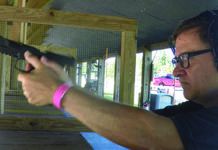
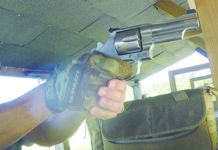
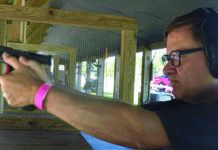
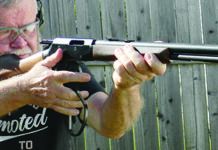
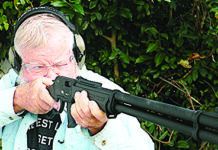
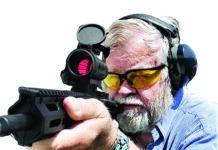
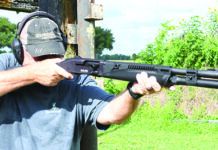
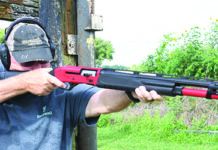
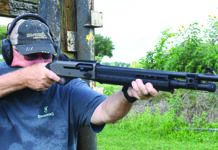
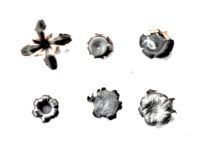
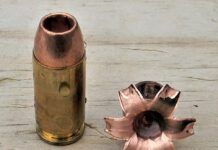

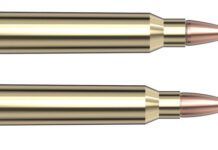
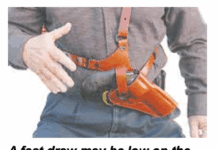
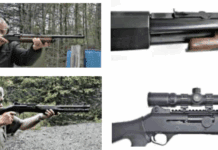



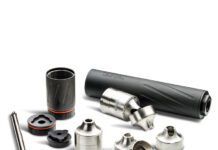
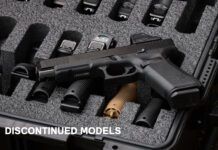

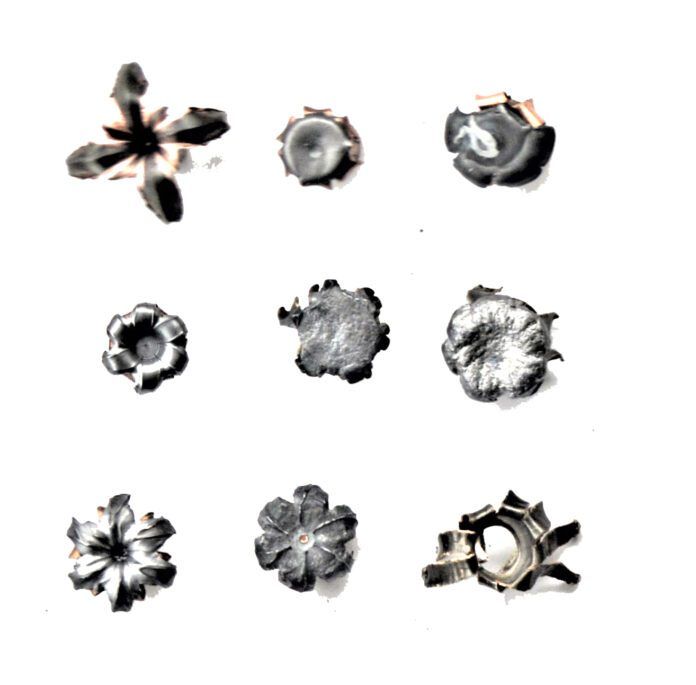

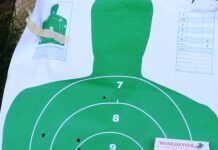

Good review and real world tests on the 9mm Luger.
I don’t remember if there has been a recent and similar review of .380 ammunition.
A lot of bullets that expand in water jugs , fail to pass the FBI test with 4 layers of denim etc in front of the gel block. They often plug up and act like an FMJ with no expansion at all. I would recommend looking up these bullets on YouTube to find performance reviews using the FBI style tests.
The ‘https://www.youtube.com/@ToolsandTargets’ channel would be a good start. There are many others as well.
No sense paying top dollar for bullets that fail to deliver in realistic scenarios.